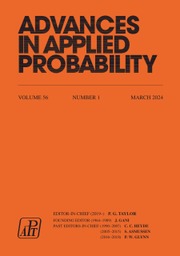No CrossRef data available.
Article contents
Cutoff for the logistic SIS epidemic model with self-infection
Published online by Cambridge University Press: 04 June 2025
Abstract
We study a variant of the classical Markovian logistic SIS epidemic model on a complete graph, which has the additional feature that healthy individuals can become infected without contacting an infected member of the population. This additional ‘self-infection’ is used to model situations where there is an unknown source of infection or an external disease reservoir, such as an animal carrier population. In contrast to the classical logistic SIS epidemic model, the version with self-infection has a non-degenerate stationary distribution, and we derive precise asymptotics for the time to converge to stationarity (mixing time) as the population size becomes large. It turns out that the chain exhibits the cutoff phenomenon, which is a sharp transition in time from one to zero of the total variation distance to stationarity. We obtain the exact leading constant for the cutoff time and show that the window size is of constant (optimal) order. While this result is interesting in its own right, an additional contribution of this work is that the proof illustrates a recently formalised methodology of Barbour, Brightwell and Luczak (2022), ‘Long-term concentration of measure and cut-off’, Stochastic Processes and their Applications 152, 378–423, which can be used to show cutoff via a combination of concentration-of-measure inequalities for the trajectory of the chain and coupling techniques.
MSC classification
Information
- Type
- Original Article
- Information
- Copyright
- © The Author(s), 2025. Published by Cambridge University Press on behalf of Applied Probability Trust


